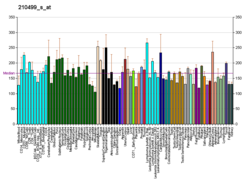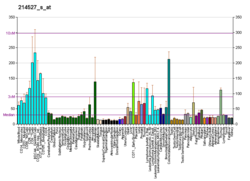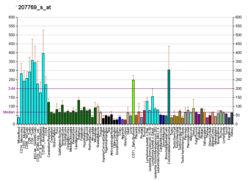Polyglutamine-binding protein 1 (PQBP1) is a protein that in humans is encoded by the PQBP1 gene.
Polyglutamine binding protein-1, which was identified as a binding protein to the polyglutamine tract sequence, is an evolutionally conserved protein expressed in various tissues including developmental and adult brains or mesodermal tissues. In cells, PQBP1 is dominantly located in the nucleus but also in the cytoplasm dependently on the cell type and stress conditions. PQBP1 has recently been found to play a role in the innate immune response of dendritic cells.
It should be of note that PQBP1 has no relationship with QBP1, an artificial synthetic peptide.
Function
PQBP1 is a nuclear polyglutamine-binding protein that contains a WW domain.
The molecular roles of PQBP1 are mainly in mRNA splicing and transcription. PQBP1 interacts with splicing proteins and RNA-binding proteins. PQBP1 deficiency critically affects mRNA splicing of cell cycle and synapse related genes. Recent results indicated implication of PQBP1 in cytoplasmic RNA metabolism and elongation of protein translation from mRNA. Research also seems to suggest that PQBP1 also plays a role in the innate immune system as a necessary adaptor for the cGAS-mediated innate response to lentiviruses such as HIV1. This PQBP-1 dependent response initiates a sensor that detects lentiviral DNA.
Clinical significance
Mutations in the PQBP1 gene, which encodes for this protein, have been known to cause X-linked intellectual disabilities (XLID), commonly referred to as Renpenning's syndrome. Recent studies indicate that PQBP-1 interaction with TXNL4A is missing in patients with frameshift mutations causing Renpenning's syndrome. PQBP-1 seems to facilitate the nuclear import of TXNL4A, however the biological function of that interaction requires further investigation. People who suffer from these disabilities share a common set of symptoms including: microcephaly, shortened stature and impaired intellectual development. There are 11 types of mutations that have been identified, but the most common being frameshift mutations. Other syndromic XLIDs such as Golabi-Ito-Hall syndrome and non-syndromic ID patients were also associated with PQBP1 gene mutations.
Mutant Ataxin-1 and Huntingtin, disease proteins of spinocerebellar ataxia type-1 and Huntington's disease respectively, interact with PQBP1 and disturbed the functions of PQBP1. Moreover, recent investigations revealed pathological roles of PQBP1 in neurons and microglia under neurodegeneration of Alzheimer's disease and tauopathy. SRRM2 phosphorylation detected in neurons at the early stage of Alzheimer's disease pathology leads to reduction of SRRM2, a scaffold protein for RNA metabolism related molecules in the nucleus, which causes reduction of PQBP1 in the nucleus and acquired intellectual disability. PQBP1 was shown as an intracellular receptor for HIV1 in dendritic cells for innate immune system. Recent studies indicate that PQBP1 recognizes intact capsids of HIV-1 particles. It interacts with these capsids through its amino-terminus, and when capsid disassembles it triggers the PQBP-1 dependent recruitment of cGAS. This is crucial to activating the sensor that detects HIV-1 DNA as soon as synthesis is initiated. Similarly, PQBP1 functions as an intracellular receptor for tau proteins and trigger brain inflammation.
Animal models
Mouse models of knockdown and conditional knockout were generated, and they showed cognitive impairment and microcephaly. The KD mice possess a transgene expressing 498 bp double-strand RNA that is endogenously cleaved to siRNA suppressing PQBP1 efficiently, and did not show obvious developmental abnormality. Another knockdown model of the gene in mouse embryo primary neurons revealed a decrease in splicing efficiency and resulted in abnormal gastrulation and neuralation patterning.
Drosophila models of underexpression and overexpression were also generated. The hypomorph Drosophila model revealed molecular function of PQBP1 in learning acquisition mediated by decreased mRNA and protein expressions of NMDA receptor subunit NR1. Research indicates that in order to appropriately function, the protein must be expressed within a critical range.
References
- ^ GRCh38: Ensembl release 89: ENSG00000102103 – Ensembl, May 2017
- ^ GRCm38: Ensembl release 89: ENSMUSG00000031157 – Ensembl, May 2017
- "Human PubMed Reference:". National Center for Biotechnology Information, U.S. National Library of Medicine.
- "Mouse PubMed Reference:". National Center for Biotechnology Information, U.S. National Library of Medicine.
- ^ Imafuku I, Waragai M, Takeuchi S, Kanazawa I, Kawabata M, Mouradian MM, Okazawa H (December 1998). "Polar amino acid-rich sequences bind to polyglutamine tracts". Biochemical and Biophysical Research Communications. 253 (1): 16–20. doi:10.1006/bbrc.1998.9725. PMID 9875212.
- Lenski C, Abidi F, Meindl A, Gibson A, Platzer M, Frank Kooy R, et al. (April 2004). "Novel truncating mutations in the polyglutamine tract binding protein 1 gene (PQBP1) cause Renpenning syndrome and X-linked mental retardation in another family with microcephaly". American Journal of Human Genetics. 74 (4): 777–780. doi:10.1086/383205. PMC 1181956. PMID 15024694.
- ^ Waragai M, Lammers CH, Takeuchi S, Imafuku I, Udagawa Y, Kanazawa I, et al. (June 1999). "PQBP-1, a novel polyglutamine tract-binding protein, inhibits transcription activation by Brn-2 and affects cell survival". Human Molecular Genetics. 8 (6): 977–987. doi:10.1093/hmg/8.6.977. PMID 10332029.
- Okazawa H, Sudol M, Rich T (November 2001). "PQBP-1 (Np/PQ): a polyglutamine tract-binding and nuclear inclusion-forming protein". Brain Research Bulletin. 56 (3–4): 273–280. doi:10.1016/S0361-9230(01)00579-2. PMID 11719261. S2CID 25290878.
- Qi Y, Hoshino M, Wada Y, Marubuchi S, Yoshimura N, Kanazawa I, et al. (September 2005). "PQBP-1 is expressed predominantly in the central nervous system during development". The European Journal of Neuroscience. 22 (6): 1277–1286. doi:10.1111/j.1460-9568.2005.04339.x. PMID 16190883. S2CID 33492223.
- ^ Iwasaki Y, Thomsen GH (October 2014). "The splicing factor PQBP1 regulates mesodermal and neural development through FGF signaling". Development. 141 (19): 3740–3751. doi:10.1242/dev.106658. PMC 4197583. PMID 25209246.
- ^ Okazawa H, Rich T, Chang A, Lin X, Waragai M, Kajikawa M, et al. (May 2002). "Interaction between mutant ataxin-1 and PQBP-1 affects transcription and cell death". Neuron. 34 (5): 701–713. doi:10.1016/S0896-6273(02)00697-9. PMID 12062018. S2CID 17652186.
- ^ Jin M, Shiwaku H, Tanaka H, Obita T, Ohuchi S, Yoshioka Y, et al. (November 2021). "Tau activates microglia via the PQBP1-cGAS-STING pathway to promote brain inflammation". Nature Communications. 12 (1): 6565. Bibcode:2021NatCo..12.6565J. doi:10.1038/s41467-021-26851-2. PMC 8592984. PMID 34782623.
- Kunde SA, Musante L, Grimme A, Fischer U, Müller E, Wanker EE, Kalscheuer VM (December 2011). "The X-chromosome-linked intellectual disability protein PQBP1 is a component of neuronal RNA granules and regulates the appearance of stress granules". Human Molecular Genetics. 20 (24): 4916–4931. doi:10.1093/hmg/ddr430. PMID 21933836.
- Yoh SM, Schneider M, Seifried J, Soonthornvacharin S, Akleh RE, Olivieri KC, et al. (June 2015). "PQBP1 Is a Proximal Sensor of the cGAS-Dependent Innate Response to HIV-1". Cell. 161 (6): 1293–1305. doi:10.1016/j.cell.2015.04.050. PMC 4503237. PMID 26046437.
- "OMIM: PQBP1 polyglutamine binding protein 1".
- ^ Ito H, Shiwaku H, Yoshida C, Homma H, Luo H, Chen X, et al. (April 2015). "In utero gene therapy rescues microcephaly caused by Pqbp1-hypofunction in neural stem progenitor cells". Molecular Psychiatry. 20 (4): 459–471. doi:10.1038/mp.2014.69. PMC 4378255. PMID 25070536.
- Okazawa H (October 2018). "PQBP1, an intrinsically disordered/denatured protein at the crossroad of intellectual disability and neurodegenerative diseases". Neurochemistry International. 119: 17–25. doi:10.1016/j.neuint.2017.06.005. PMID 28627366. S2CID 28886506.
- Mizuguchi M, Obita T, Serita T, Kojima R, Nabeshima Y, Okazawa H (April 2014). "Mutations in the PQBP1 gene prevent its interaction with the spliceosomal protein U5-15 kD". Nature Communications. 5: 3822. Bibcode:2014NatCo...5.3822M. doi:10.1038/ncomms4822. PMID 24781215.
- Zhang Y, Lindblom T, Chang A, Sudol M, Sluder AE, Golemis EA (October 2000). "Evidence that dim1 associates with proteins involved in pre-mRNA splicing, and delineation of residues essential for dim1 interactions with hnRNP F and Npw38/PQBP-1". Gene. 257 (1): 33–43. doi:10.1016/S0378-1119(00)00372-3. PMID 11054566.
- Waragai M, Junn E, Kajikawa M, Takeuchi S, Kanazawa I, Shibata M, et al. (July 2000). "PQBP-1/Npw38, a nuclear protein binding to the polyglutamine tract, interacts with U5-15kD/dim1p via the carboxyl-terminal domain". Biochemical and Biophysical Research Communications. 273 (2): 592–595. doi:10.1006/bbrc.2000.2992. PMID 10873650.
- Mizuguchi M, Obita T, Serita T, Kojima R, Nabeshima Y, Okazawa H (April 2014). "Mutations in the PQBP1 gene prevent its interaction with the spliceosomal protein U5-15 kD". Nature Communications. 5 (1): 3822. Bibcode:2014NatCo...5.3822M. doi:10.1038/ncomms4822. PMID 24781215.
- Wang Q, Moore MJ, Adelmant G, Marto JA, Silver PA (March 2013). "PQBP1, a factor linked to intellectual disability, affects alternative splicing associated with neurite outgrowth". Genes & Development. 27 (6): 615–626. doi:10.1101/gad.212308.112. PMC 3613609. PMID 23512658.
- Komuro A, Saeki M, Kato S (December 1999). "Association of two nuclear proteins, Npw38 and NpwBP, via the interaction between the WW domain and a novel proline-rich motif containing glycine and arginine". The Journal of Biological Chemistry. 274 (51): 36513–36519. doi:10.1074/jbc.274.51.36513. PMID 10593949.
- Llorian M, Beullens M, Andrés I, Ortiz JM, Bollen M (February 2004). "SIPP1, a novel pre-mRNA splicing factor and interactor of protein phosphatase-1". The Biochemical Journal. 378 (Pt 1): 229–238. doi:10.1042/bj20030950. PMC 1223944. PMID 14640981.
- Musante L, Kunde SA, Sulistio TO, Fischer U, Grimme A, Frints SG, et al. (January 2010). "Common pathological mutations in PQBP1 induce nonsense-mediated mRNA decay and enhance exclusion of the mutant exon". Human Mutation. 31 (1): 90–98. doi:10.1002/humu.21146. PMID 19847789. S2CID 23152883.
- Shen Y, Zhang ZC, Cheng S, Liu A, Zuo J, Xia S, et al. (April 2021). "PQBP1 promotes translational elongation and regulates hippocampal mGluR-LTD by suppressing eEF2 phosphorylation". Molecular Cell. 81 (7): 1425–1438.e10. doi:10.1016/j.molcel.2021.01.032. PMID 33662272. S2CID 232122674.
- ^ Yoh SM, Mamede JI, Lau D, Ahn N, Sánchez-Aparicio MT, Temple J, et al. (August 2022). "Recognition of HIV-1 capsid by PQBP1 licenses an innate immune sensing of nascent HIV-1 DNA". Molecular Cell. 82 (15): 2871–2884.e6. doi:10.1016/j.molcel.2022.06.010. PMC 9552964. PMID 35809572.
- ^ Stevenson RE, Bennett CW, Abidi F, Kleefstra T, Porteous M, Simensen RJ, et al. (May 2005). "Renpenning syndrome comes into focus". American Journal of Medical Genetics. Part A. 134 (4): 415–421. doi:10.1002/ajmg.a.30664. PMID 15782410. S2CID 24333408.
- Liu X, Dou LX, Han J, Zhang ZC (March 2020). "The Renpenning syndrome-associated protein PQBP1 facilitates the nuclear import of splicing factor TXNL4A through the karyopherin β2 receptor". The Journal of Biological Chemistry. 295 (13): 4093–4100. doi:10.1074/jbc.RA119.012214. PMC 7105315. PMID 32041777.
- Kalscheuer VM, Freude K, Musante L, Jensen LR, Yntema HG, Gécz J, et al. (December 2003). "Mutations in the polyglutamine binding protein 1 gene cause X-linked mental retardation". Nature Genetics. 35 (4): 313–315. doi:10.1038/ng1264. hdl:11858/00-001M-0000-0010-8953-D. PMID 14634649. S2CID 27007340.
- Germanaud D, Rossi M, Bussy G, Gérard D, Hertz-Pannier L, Blanchet P, et al. (March 2011). "The Renpenning syndrome spectrum: new clinical insights supported by 13 new PQBP1-mutated males". Clinical Genetics. 79 (3): 225–235. doi:10.1111/j.1399-0004.2010.01551.x. PMID 20950397. S2CID 22909872.
- Lubs H, Abidi FE, Echeverri R, Holloway L, Meindl A, Stevenson RE, Schwartz CE (June 2006). "Golabi-Ito-Hall syndrome results from a missense mutation in the WW domain of the PQBP1 gene". Journal of Medical Genetics. 43 (6): e30. doi:10.1136/jmg.2005.037556. PMC 2564547. PMID 16740914.
- Tapia VE, Nicolaescu E, McDonald CB, Musi V, Oka T, Inayoshi Y, et al. (June 2010). "Y65C missense mutation in the WW domain of the Golabi-Ito-Hall syndrome protein PQBP1 affects its binding activity and deregulates pre-mRNA splicing". The Journal of Biological Chemistry. 285 (25): 19391–19401. doi:10.1074/jbc.M109.084525. PMC 2885219. PMID 20410308.
- Sudol M, McDonald CB, Farooq A (August 2012). "Molecular insights into the WW domain of the Golabi-Ito-Hall syndrome protein PQBP1". FEBS Letters. 586 (17): 2795–2799. doi:10.1016/j.febslet.2012.03.041. PMC 3413755. PMID 22710169.
- Busch A, Engemann S, Lurz R, Okazawa H, Lehrach H, Wanker EE (October 2003). "Mutant huntingtin promotes the fibrillogenesis of wild-type huntingtin: a potential mechanism for loss of huntingtin function in Huntington's disease". The Journal of Biological Chemistry. 278 (42): 41452–41461. doi:10.1074/jbc.M303354200. PMID 12888569.
- ^ Tanaka H, Kondo K, Chen X, Homma H, Tagawa K, Kerever A, et al. (October 2018). "The intellectual disability gene PQBP1 rescues Alzheimer's disease pathology". Molecular Psychiatry. 23 (10): 2090–2110. doi:10.1038/s41380-018-0253-8. PMC 6250680. PMID 30283027.
- Tagawa K, Homma H, Saito A, Fujita K, Chen X, Imoto S, et al. (January 2015). "Comprehensive phosphoproteome analysis unravels the core signaling network that initiates the earliest synapse pathology in preclinical Alzheimer's disease brain". Human Molecular Genetics. 24 (2): 540–558. doi:10.1093/hmg/ddu475. PMID 25231903.
- Yoh SM, Schneider M, Seifried J, Soonthornvacharin S, Akleh RE, Olivieri KC, et al. (June 2015). "PQBP1 Is a Proximal Sensor of the cGAS-Dependent Innate Response to HIV-1". Cell. 161 (6): 1293–1305. doi:10.1016/j.cell.2015.04.050. PMC 4503237. PMID 26046437.
- ^ Ito H, Yoshimura N, Kurosawa M, Ishii S, Nukina N, Okazawa H (November 2009). "Knock-down of PQBP1 impairs anxiety-related cognition in mouse". Human Molecular Genetics. 18 (22): 4239–4254. doi:10.1093/hmg/ddp378. PMID 19661183.
- ^ Tamura T, Horiuchi D, Chen YC, Sone M, Miyashita T, Saitoe M, et al. (October 2010). "Drosophila PQBP1 regulates learning acquisition at projection neurons in aversive olfactory conditioning". The Journal of Neuroscience. 30 (42): 14091–14101. doi:10.1523/JNEUROSCI.1319-10.2010. PMC 6634781. PMID 20962230.
- Yoshimura N, Horiuchi D, Shibata M, Saitoe M, Qi ML, Okazawa H (April 2006). "Expression of human PQBP-1 in Drosophila impairs long-term memory and induces abnormal courtship". FEBS Letters. 580 (9): 2335–2340. doi:10.1016/j.febslet.2006.03.056. PMID 16597440. S2CID 21490164.
- Tamura T, Sone M, Nakamura Y, Shimamura T, Imoto S, Miyano S, Okazawa H (January 2013). "A restricted level of PQBP1 is needed for the best longevity of Drosophila". Neurobiology of Aging. 34 (1): 356.e11–356.e20. doi:10.1016/j.neurobiolaging.2012.07.015. PMID 22901698. S2CID 17527056.
Further reading
- Fox P, Fox D, Gerrard JW (1981). "X-linked mental retardation: Renpenning revisited". American Journal of Medical Genetics. 7 (4): 491–495. doi:10.1002/ajmg.1320070409. PMID 7211958.
- Stevenson RE, Arena JF, Ouzts E, Gibson A, Shokeir MH, Vnencak-Jones C, et al. (May 1998). "Renpenning syndrome maps to Xp11". American Journal of Human Genetics. 62 (5): 1092–1101. doi:10.1086/301835. PMC 1377092. PMID 9545405.
- Deqaqi SC, N'Guessan M, Forner J, Sbiti A, Beldjord C, Chelly J, et al. (1998). "A gene for non-specific X-linked mental retardation (MRX55) is located in Xp11". Annales de Génétique. 41 (1): 11–16. PMID 9599645.
- Komuro A, Saeki M, Kato S (May 1999). "Npw38, a novel nuclear protein possessing a WW domain capable of activating basal transcription". Nucleic Acids Research. 27 (9): 1957–1965. doi:10.1093/nar/27.9.1957. PMC 148407. PMID 10198427.
- Komuro A, Saeki M, Kato S (December 1999). "Association of two nuclear proteins, Npw38 and NpwBP, via the interaction between the WW domain and a novel proline-rich motif containing glycine and arginine". The Journal of Biological Chemistry. 274 (51): 36513–36519. doi:10.1074/jbc.274.51.36513. PMID 10593949.
- Waragai M, Junn E, Kajikawa M, Takeuchi S, Kanazawa I, Shibata M, et al. (July 2000). "PQBP-1/Npw38, a nuclear protein binding to the polyglutamine tract, interacts with U5-15kD/dim1p via the carboxyl-terminal domain". Biochemical and Biophysical Research Communications. 273 (2): 592–595. doi:10.1006/bbrc.2000.2992. PMID 10873650.
- Zhang Y, Lindblom T, Chang A, Sudol M, Sluder AE, Golemis EA (October 2000). "Evidence that dim1 associates with proteins involved in pre-mRNA splicing, and delineation of residues essential for dim1 interactions with hnRNP F and Npw38/PQBP-1". Gene. 257 (1): 33–43. doi:10.1016/S0378-1119(00)00372-3. PMID 11054566.
- Iwamoto K, Huang Y, Ueda S (December 2000). "Genomic organization and alternative transcripts of the human PQBP-1 gene". Gene. 259 (1–2): 69–73. doi:10.1016/S0378-1119(00)00437-6. PMID 11163963.
- Okazawa H, Rich T, Chang A, Lin X, Waragai M, Kajikawa M, et al. (May 2002). "Interaction between mutant ataxin-1 and PQBP-1 affects transcription and cell death". Neuron. 34 (5): 701–713. doi:10.1016/S0896-6273(02)00697-9. PMID 12062018.
- Kalscheuer VM, Freude K, Musante L, Jensen LR, Yntema HG, Gécz J, et al. (December 2003). "Mutations in the polyglutamine binding protein 1 gene cause X-linked mental retardation". Nature Genetics. 35 (4): 313–315. doi:10.1038/ng1264. hdl:11858/00-001M-0000-0010-8953-D. PMID 14634649. S2CID 27007340.
- Brandenberger R, Wei H, Zhang S, Lei S, Murage J, Fisk GJ, et al. (June 2004). "Transcriptome characterization elucidates signaling networks that control human ES cell growth and differentiation". Nature Biotechnology. 22 (6): 707–716. doi:10.1038/nbt971. PMID 15146197. S2CID 27764390.
- Kleefstra T, Franken CE, Arens YH, Ramakers GJ, Yntema HG, Sistermans EA, et al. (October 2004). "Genotype-phenotype studies in three families with mutations in the polyglutamine-binding protein 1 gene (PQBP1)". Clinical Genetics. 66 (4): 318–326. doi:10.1111/j.1399-0004.2004.00308.x. PMID 15355434. S2CID 34100315.
- Andersen JS, Lam YW, Leung AK, Ong SE, Lyon CE, Lamond AI, Mann M (January 2005). "Nucleolar proteome dynamics". Nature. 433 (7021): 77–83. Bibcode:2005Natur.433...77A. doi:10.1038/nature03207. PMID 15635413. S2CID 4344740.
- Stevenson RE, Bennett CW, Abidi F, Kleefstra T, Porteous M, Simensen RJ, et al. (May 2005). "Renpenning syndrome comes into focus". American Journal of Medical Genetics. Part A. 134 (4): 415–421. doi:10.1002/ajmg.a.30664. PMID 15782410. S2CID 24333408.
- Marubuchi S, Wada Y, Okuda T, Hara Y, Qi ML, Hoshino M, et al. (November 2005). "Polyglutamine tract-binding protein-1 dysfunction induces cell death of neurons through mitochondrial stress". Journal of Neurochemistry. 95 (3): 858–870. doi:10.1111/j.1471-4159.2005.03405.x. PMID 16104847. S2CID 30033589.
External links
- PQBP1 human gene location in the UCSC Genome Browser.
- PQBP1 human gene details in the UCSC Genome Browser.
- Overview of all the structural information available in the PDB for UniProt: O60828 (Polyglutamine-binding protein 1) at the PDBe-KB.






